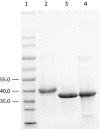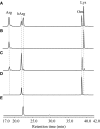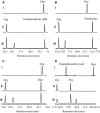Characterization of AmtA, an amidinotransferase involved in the biosynthesis of phaseolotoxins
- PMID: 27419063
- PMCID: PMC4887976
- DOI: 10.1002/2211-5463.12071
Characterization of AmtA, an amidinotransferase involved in the biosynthesis of phaseolotoxins
Abstract
Phaseolotoxins (PHTs), which are produced by Pseudomonas, belong to a family of phosphoramidate natural products. Two nonproteinogenic amino acid precursors, N(δ)(N'-sulfo-diaminophosphinyl)-ornithine (PSOrn) and homoarginine (hArg), are involved in biosynthesis of PHTs. Amidinotransferase AmtA catalyses the formation of hArg, with arginine and lysine as substrates. AmtA was overexpressed and purified in an Escherichia coli system. An in vitro enzyme assay showed that it has stricter substrate specificity than certain other amidinotransferases. Site-directed mutagenesis experiments showed that the mutation AmtA Met243His244 is an alternative while Met246 is essential for the transamidination activity.
Keywords: amidinotransferase; biosynthesis; homoarginine; phaseolotoxin.
Figures







Similar articles
-
Isolation and characterization of the gene coding for the amidinotransferase involved in the biosynthesis of phaseolotoxin in Pseudomonas syringae pv. phaseolicola.Mol Plant Microbe Interact. 2001 Apr;14(4):545-54. doi: 10.1094/MPMI.2001.14.4.545. Mol Plant Microbe Interact. 2001. PMID: 11310742
-
Ornithine Transcarbamylase ArgK Plays a Dual role for the Self-defense of Phaseolotoxin Producing Pseudomonas syringae pv. phaseolicola.Sci Rep. 2015 Aug 10;5:12892. doi: 10.1038/srep12892. Sci Rep. 2015. PMID: 26256666 Free PMC article.
-
Functional characterization of the gene cluster from Pseudomonas syringae pv. phaseolicola NPS3121 involved in synthesis of phaseolotoxin.J Bacteriol. 2007 Apr;189(7):2834-43. doi: 10.1128/JB.01845-06. Epub 2007 Jan 19. J Bacteriol. 2007. PMID: 17237165 Free PMC article.
-
Homoarginine in the renal and cardiovascular systems.Amino Acids. 2015 Sep;47(9):1703-13. doi: 10.1007/s00726-015-1993-2. Epub 2015 May 1. Amino Acids. 2015. PMID: 25929587 Review.
-
Homoarginine in the shadow of asymmetric dimethylarginine: from nitric oxide to cardiovascular disease.Amino Acids. 2015 Sep;47(9):1741-50. doi: 10.1007/s00726-015-2017-y. Epub 2015 Jun 27. Amino Acids. 2015. PMID: 26123985 Review.
Cited by
-
The virulence-associated protein HsvA from the fire blight pathogen Erwinia amylovora is a polyamine amidinotransferase.J Biol Chem. 2017 Dec 29;292(52):21366-21380. doi: 10.1074/jbc.M117.815951. Epub 2017 Nov 9. J Biol Chem. 2017. PMID: 29123034 Free PMC article.
-
Association of Lower Plasma Homoarginine Concentrations with Greater Risk of All-Cause Mortality in the Community: The Framingham Offspring Study.J Clin Med. 2020 Jun 26;9(6):2016. doi: 10.3390/jcm9062016. J Clin Med. 2020. PMID: 32604958 Free PMC article.
-
Precursor-Guided Mining of Marine Sponge Metabolomes Lends Insight into Biosynthesis of Pyrrole-Imidazole Alkaloids.ACS Chem Biol. 2020 Aug 21;15(8):2185-2194. doi: 10.1021/acschembio.0c00375. Epub 2020 Jul 29. ACS Chem Biol. 2020. PMID: 32662980 Free PMC article.
-
Presence of Bromotyrosine Alkaloids in Marine Sponges Is Independent of Metabolomic and Microbiome Architectures.mSystems. 2021 Mar 16;6(2):e01387-20. doi: 10.1128/mSystems.01387-20. mSystems. 2021. PMID: 33727403 Free PMC article.
References
-
- Gross H and Loper JE (2009) Genomics of secondary metabolite production by Pseudomonas spp. Nat Prod Rep 26, 1408–1446. - PubMed
-
- Renzi M, Copini P, Taddei AR, Rossetti A, Gallipoli L, Mazzaglia A and Balestra GM (2012) Bacterial canker on kiwifruit in Italy: anatomical changes in the wood and in the primary infection sites. Phytopathology 102, 827–840. - PubMed
-
- Langley DB, Templeton MD, Fields BA, Mitchell RE and Collyer CA (2000) Mechanism of inactivation of ornithine transcarbamoylase by Nδ‐(N′‐Sulfodiaminophosphinyl)‐L‐ornithine, a true transition state analogue? Crystal structure and implications for catalytic mechanism. J Biol Chem 275, 20012–20019. - PubMed
LinkOut - more resources
Full Text Sources
Other Literature Sources

